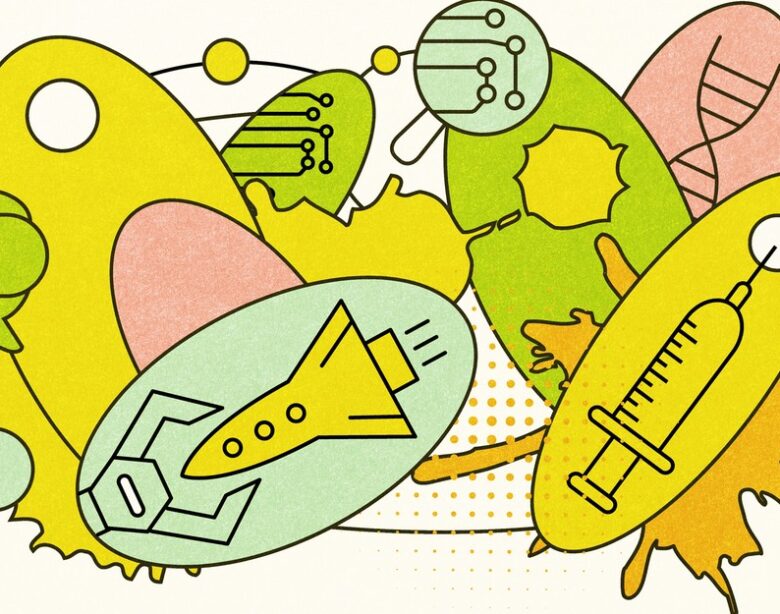[ad_1]
This is the third time I’ve praised what I see as the year’s most important scientific and technological advances.
In 2022, my theme is the principle of “Two thoughts” when similar inventions occur at the same time Just as Alexander Graham Bell and Elisha Gray both thought of the modern telephone in 1876 (and in some cases on the same day!) The United States also saw many successes in the field of GENERATION AI, cancer treatment. and vaccinology
In 2023, my idea is a long road of progress. My biggest breakthrough is Casgevy, a gene-editing therapy for patients with sickle cell anemia. The therapy builds on decades of research into CRISPR, an immune defense system borrowed from the world of bacteria.
This year my theme is the power of small improvements in small steps. This is also the concept of technological advancement. While no breakthrough in 2024 will compare to the launch of ChatGPT or the first discovery of GLP-1 drugs like Ozempic, this year we have seen several advances. In the medical field space technology and AI, which expand our knowledge in consequential ways
Smart protection against HIV
Worldwide, 40 million people are infected with HIV, and approximately 630,000 people die from AIDS every year. There is no cure for this disease. But while patients in developed countries have access to drugs that protect against the virus, But many people in poorer countries where the disease is more widespread are left without access.
This year, scientists from the pharmaceutical company Gilead announced that a new injectable drug appears to provide excellent protection against HIV for six months. In one clinical trial on South African and Ugandan girls and young women, An injection called lenakapavir A 100 percent reduction in HIV infection was achieved in the intervention group. Another trial of people on several continents reported an efficacy rate of 96 percent. Clinical trial results couldn’t have been more successful.
This fall, Gilead agree To allow other companies to sell cheap generic shots in poor countries The agreement makes middle-income countries such as Brazil and Mexico pay more for treatment.
Lenacapavir works by targeting It’s an important “capsid protein” that acts as both a sword and shield for HIV’s genetic material, protecting the virus’s RNA and allowing it to invade our cells. Lenacapavir numbs the protein and disarms the sword and shield’s function. This makes the HIV virus particles harmless. In naming Lenakapavir Breakthrough of the yearjournal science The same technique has been reported to destroy proteins that protect against countless other deadly viruses. This includes viruses that cause the common cold or even once-in-a-generation pandemics. The ability to disrupt the structure and function of these viruses by targeting the capsid protein could help us treat many diseases. get more in the long run
The United States enters the era of rocket capture.
For six decades, the United States It’s pretty good at using propulsion technology to throw heavy objects into space. But catch them as they fall to earth? not a lot.
Until this October When a SpaceX spaceship falls from the sky 22 times the speed of soundSlam on the brakes, slowing over the same tower that left it on. and sat down on two giant mechanical arms for a high-tech hug. Sixty-six years after America entered the age of rocket launches, America is finally entering the age of rocket capture.
So what is the use of this needle-nose pliers technology, nicknamed “chopsticks”, really? SpaceX, founded and run by Elon Musk, has already lowered the price of launching things into space by an order of magnitude. Making rockets fully reusable could lower prices. “One more step down.” write Eric Hand, journalist with science– Almost every aspect of space-bound economy. Whether it is a scientific experiment in our solar system Asteroid mining Optical fiber production and pharmaceuticals in microgravity They all run counter to the same basic economic bottleneck: ejecting things from our atmosphere is still very expensive. But rockets are cheap, big and reusable. It is a prerequisite for any world building. Beyond our own world Whether it is a small automated factory group that buzzes in low orbit, in other words, a multiplanetary civilization
Quantum progress
In December, Google announced that a new quantum computer using a chip called Willow could solve math problems in five minutes. This will take approximately one of the fastest supercomputers. “10 seven million years” To crack, for context, 10. Seven million years is the entire history of the universe (about 14 billion years), repeated trillions of times. The feat was so bold that some speculated that Google’s computers worked by borrowing processing power from a parallel universe.
If that paragraph caused a nauseating mix of doubt and bewilderment, That is considered correct. Quantum computers don’t make sense to most people. This is partly because they are hailed as the ultimate supercomputers. But as Cleo Abrams, a science journalist, explainThat’s a misnomer. You shouldn’t think that quantum computers are bigger, faster, or smarter than our everyday computers. You should think of them as fundamentally different.
Traditional computers like your smartphone and laptop It processes information in the same way as a parade of binary switches that flip between 1 and 0. Quantum computers use qubits, which govern quantum mechanics. This is the strange physics that governs particles smaller than atoms. A qubit can express both a 1 and a 0 at the same time, thanks to a property called superposition As you add more qubits Computational power will increase exponentially. This theoretically allows quantum computers to solve dizzyingly complex problems.
Qubits are picky and prone to errors. That’s one reason quantum computers are kept in special containers with temperatures close to 0 Kelvin, a temperature cooler than deep space. But Google’s chip, which has 105 qubits connected, is one of the first. That shows that the number of errors can be reduced as more qubits are added, a discovery that future quantum computing teams are sure to build on.
If you look at it positively Quantum computers can help us understand the laws of subatomic activity. which underlies all physical reality. That could mean designing better electric batteries by having researchers simulate the behavior of electrons in metals. or revolutionize drug discovery by predicting interactions between our immune system and viruses at the most minimal level.
But the possibilities aren’t all pretty. The United States, China, and other countries Caught in the multi-billion dollar race towards quantum supremacy. This is partly because it is widely understood that a fully functioning quantum computer can solve the complex mathematical problems that underlie public-key cryptography. In other words, A working quantum computer could nullify much of the internet’s encryption. Once again, technology’s power to do more good tends to increase with its power to cause more chaos.
Another year of magic Generative-AI
This might be the era where any possible list of the year’s most important technological advances would end with the sentence Oh, and artificial intelligence researchers do a lot of crazy stuff too.–
Over the past three months, there has been little study. meet ChatGPT outperforms human doctors in editing patient records; Several AI companies have launched a number of impressive video creation programs, including Google DeepMind’s Veo 2 and OpenAI Google’s Sora. Announced AI agents with weather forecasts outperform the European Mid-Range Weather Forecast Center—”The world leader in atmospheric forecasting,” follow The New York Times– and OpenAI has launched a system The new “reasoning” Breaking industry standards in coding and complex math problems
I remain interested in how the autopilot technology behind large language models handles even the most complex logic systems. Researchers have shown that AI can master a language’s syntax well enough to create believable sentences, codes, and poems with ChatGPT. But the universe is full of other languages. That is another logical system. that follows a limited number of rules to achieve predictable results One example is DNA. After all, what is DNA if not language? with words based on four letters or nucleotides Our genetic code thus spells out how our proteins, cells, organs, and bodies should work, replicate, and develop if one LLM masters the logic of the English language and computer programming. Perhaps another person will master the DNA syntax that allows scientists to synthesize biology in the lab in the same way that you or I can create synthetic paragraphs on our personal computers.
To that end, this year researchers from the Arc Institute, Stanford University, and UC Berkeley created Evo, a new AI model trained on 2.7 million genomes from microorganisms and viruses. Evo acts as a linguistic master. It learns the rules of DNA over billions of years of evolution to predict its behavior. Mutation analysis and even design new genetic sequences
What can scientists do with generative AI for biology? Think of CRISPR technology. Scientists use special proteins to cut cell DNA, like molecular scissors. This allows researchers to make basic genome edits. This year, Evo scientists redesigned the entire original protein. which is not known in nature which can perform similar gene-editing functions, as Patrick Hsu, principal investigator at the Arc Institute and assistant professor of bioengineering at UC Berkeley, says, just as tools like ChatGPT have “revolutionized the way we work with text, voice, and Video The same creative abilities can be applied to The basic code of life.”
[ad_2]
Source link



